
JUMP TO

TRANSLATE

OTHER VERSIONS OF THIS READING
INTRODUCTION
The African American fight for equal rights was the most visible of the battles for civil rights that took place in the years after World War II. However, other minority groups also worked to win equal rights and respect. Mexican Americans, Native Americans, disabled Americans, and homosexual Americans all found ways to improve their lives.
Like the African American Civil Rights Movement in the South, some of these movements had great leaders, marches, new laws, and creative protests. Some were violent, while others used nonviolence. Some were successful, while others ended without meeting their goals.
In the end, we can look at these movements as a group and think about what made them similar and different, and also why some succeeded while others did not.
What do you think? What makes a movement successful?
THE MEXICAN AMERICAN FIGHT FOR CIVIL RIGHTS
Like the African American movement, the Mexican American civil rights movement first had victories in the courts. In 1947, in Mendez v. Westminster, a court in California ruled that segregating students of Hispanic descent was unconstitutional. In 1954, the same year as Brown v. Board of Education, Mexican Americans won in Hernandez v. Texas, when the Supreme Court said that the Fourteenth Amendment protection of equality applied to all groups in the United States, including Hispanics.
These court cases were important, but the most famous fight for equal rights by Mexican Americans was led by Cesar Chavez and Dolores Huerta. They organized migrant farmworkers in California. In 1962, Chavez and Huerta started the National Farm Workers Association (NFWA). In 1965, Filipino grape pickers led by Filipino American Larry Itliong went on strike to try to get better working conditions for farmworkers in California’s Central Valley. The Filipino Americans and Mexican Americans who picked everyone’s food worked for almost no money, had no health care, and could not send their children to school. Working in the fields was hard, and in many places, there were no bathrooms and men, women and children had no choice but to relieve themselves in front of the other workers in the fields.
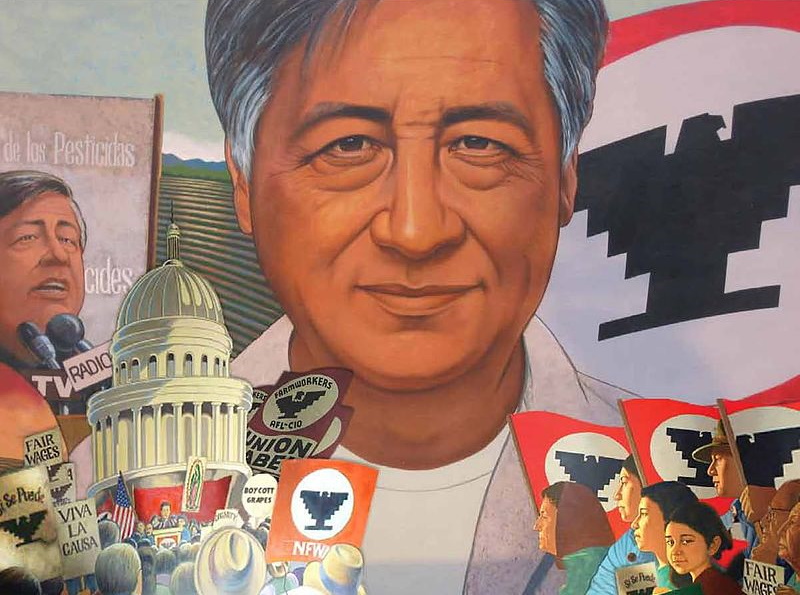 Secondary Source: Mural
Secondary Source: Mural
A mural showing Cesar Chavez and the United Farm Workers black eagle logo, as well as the marches and farmworkers he led.
Chavez, Huerta and the Mexican American farmworkers voted to join the Filipino workers on strike and the two unions joined together and became the United Farm Workers. The farm workers under Chavez used many of the same ideas that the African Americans were using in the South. For example, they used marches to get people to notice the problems they faced. In 1966, Chavez led the farm workers on a march 300-miles from Delano, California to the state’s capital of Sacramento.
They wanted to make the growers who owned the farms and the state government treat them better. The farmworkers also got the support of the powerful AFL-CIO union.
However, the strike by the farmworkers was not working, so they changed their strategy. In the end, it was a boycott of California grapes that made the difference. Farmworkers convinced many Americans to stop buying grapes grown in California and grape sales went down year after year. The Delano Grape Strike and Boycott finally ended in 1970 when California growers agreed to work with the union. The farmworkers had been on strike for eight years. Most had lost everything but felt that it had been worth it to be treated fairly.
The mirror of the Black Power movement among Mexican Americans was the Chicano Movement. Chicano activists wanted more power for Mexican Americans in government. They wanted better schools where their culture and languages were respected, and they wanted land that had been taken from them at the end of the Mexican American War in 1848. One of the leaders, Rodolfo “Corky” Gonzales, launched the Crusade for Justice in Denver in 1965, to provide jobs, legal services, and healthcare for Mexican Americans. They started La Raza Unida, a political party that gave young Hispanics an alternative to voting for White candidates from the two main political parties. Another leader, Reies López Tijerina, fought for years to get back lands that Hispanics lost to Whites. He also helped lead the Poor People’s March on Washington in 1967.
Some female Chicano activists worked on things that mattered to Chicana women. They formed the Comisión Femenil Mexicana Nacional. Some doctors had been sterilizing Hispanic women to stop them from having children, but the consent forms were only in English, so the women didn’t know what they were signing. The Comisión Femenil Mexicana Nacional went to court and in the case Madrigal v. Quilligan, they won, so consent forms would be printed in both English and Spanish. Many government documents are now in both English and Spanish because of the work of these Chicano women.
The Chicano Movement was important in the growing sense of identity and pride. Part of that identity is based on the history of the American Southwest as the first home of the Mexican people. This idea was shared by Aberto Baltazar Urista Heredia who used the name Aztlán to talk about the lands of Northern Mexico that were taken by the United States at the end of the Mexican American War. Some people thought that the southwestern United States was the original home of the Aztec people. They felt that Mexican Americans moving into Texas, New Mexico, Arizona, Nevada, Utah, and California are returning home rather than immigrating. The idea of Aztlán became a symbol for Chicano activists who thought they had a legal right to the land.
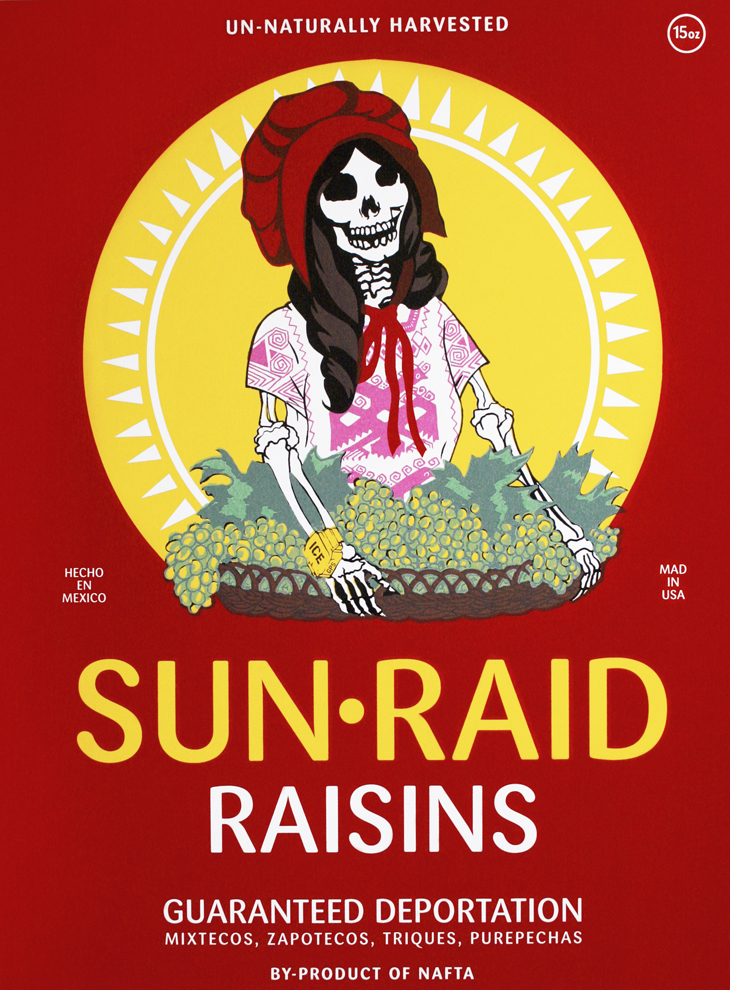 Primary Source: Painting
Primary Source: Painting
Artwork with political themes is common in the Chicano Movement. This painting by Ester Hernandez criticizes the role of big business and government in the lives of farmworkers.
Like the Harlem Renaissance of the 1920s, the Chicano Movement was pushed forward by the work of artists and writers. Chicano artists tried to show their cultural identity by mixing Mexican, American and indigenous cultures. For example, the Virgin of Guadalupe, an important figure in Mexican culture, is used by Chicano artists as a symbol of both hope in times of suffering, and strength, particularly when showing a regular woman or showing someone fighting back. One of the most celebrated holidays in Mexican culture is the Day of the Dead and the symbols of the holiday have been mixed into the Chicano Movement. Chicano art uses ideas from the famous Mexican painters such as Diego Rivera and José Orozco, and also uses ideas from pre-Columbian art, where history was shown on the walls of pyramids.
A favorite topic of Chicano artists is life in the barrios of Western cities. People in these Spanish-speaking neighborhoods have lived a hard life for a long time. Chicano artists have also used graffiti as a way to share their political ideas, history, culture and religion.
THE AMERICAN INDIAN MOVEMENT
The story of the first people of North America is long and sad. Because of diseases from Europe, Asia and Africa, about 90% of all Native Americans died. Over the years, Native Americans lost their land in many failed wars and broken treaties. In the late 1800s, the last groups of Native Americans were forced onto reservations as their old way of life was destroyed. The government wanted to force them to join White society, but their lives were hard because they were poor and because of bad schools, racism, and the fact that most Native Americans did not want to give up their culture.
In the 1930s, laws called the Indian New Deal were passed which stopped the effort to destroy Native culture. This was a good step in the right direction, but it did not fix the problems on the reservations. In 1970, the average Native American lived 46 years, but the average American lived for 69 years. The suicide rate was twice as high as the overall country, and the infant mortality rate was the highest in the country. Half of all Native Americans lived on reservations, where 50% had no jobs. For Native Americans who lived in cities, 20% were poor.
In 1968, a group of Indian activists, including Dennis Banks and George Mitchell met in Minneapolis, Minnesota, and formed the American Indian Movement (AIM).
A year later, another group of Native American activists landed on Alcatraz Island, an old prison, in San Francisco Bay. They said they were going to build a Native American cultural center, including a history museum, a nature center, and a church. Supporters gave them food and other supplies and famous people visited Alcatraz to help get attention. More people came to the island until, at one point, there were almost 400 people there. From the beginning, the federal government tried to get them to leave since the island belonged to the federal government. The Native Americans argued that the land should belong to them based on an old treaty from 1851. After 19 months, the government got the protesters to leave by cutting off all water and electricity. The occupation of Alcatraz is seen by many as a success because it got attention and people started talking about the problems Native Americans were having.
The next big demonstration came in 1972 when AIM members and other groups traveled from California to Washington, DC in a journey they called the Trail of Broken Treaties. There, they occupied the offices of the Bureau of Indian Affairs (BIA). The group gave a list of demands, which included better housing, education, and more jobs in Native communities, new treaties, the return of lands, and protections for Native religions and culture. Because of the Trail of Broken Treaties demonstration, Congress passed The Indian Self-Determination and Education Assistance Act of 1975. This law changed how tribes get government money. Instead of the government deciding how to spend money at the reservations, it is now given to tribes as grants which they could then use as they thought was best. It was an important step in giving Native Americans control over their own lives.
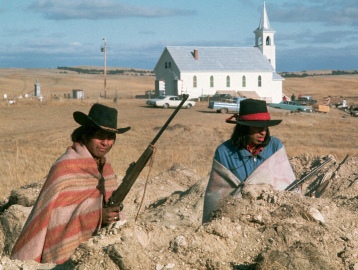 Primary Source: Photograph
Primary Source: Photograph
Members of AIM guard their positions outside the church at Wounded Knee during the standoff there in 1973.
The most famous thing AIM did was to take control of the town of Wounded Knee, South Dakota in February 1973. They took control of the small store and church and said the town was no longer part of the United States. Wounded Knee was important to AIM since the Army had killed hundreds of Native Americans there in 1890. Armed only with rifles, AIM members faced off with marshals, FBI agents and police with machine guns, helicopters, and army trucks. The police and FBI surrounded the town for 71 days. Two police officers were hurt, and two Native Americans were killed. Finally, older Native American leaders told the young AIM members to give up so that more people would not get hurt. Both sides agreed to put down their guns and the AIM members began to leave the town.
Two AIM leaders, Dennis Banks and Russell Means, were arrested and put on trial, but charges were dropped when the judge decided that the government lawyers had broken rules about fairness during the trial.
By this time, President Nixon had already tried to fix some of the problems that AIM and other Native Americans had brought up. The government gave some land back to Native Americans, spent more money on healthcare, legal services, housing, schools and jobs. They had also hired more Native Americans to work for the government at the Bureau of Indian Affairs. The most important result of the fight at Wounded Knee, however, was more pride among Native Americans and that more people learned about problems Native Americans were facing.
The relationship between Native Americans and the government continues to be hard. Many Native Americans still do not trust the government. One member of AIM, Leonard Peltier has become a symbol of this lack of trust. In 1977, he was sent to jail for the shooting of two FBI officers. But the trial was not normal, and some Native Americans want to “Free Leonard Peltier” because they think he did not do it.
Today, many Native Americans are working to stop sports teams from using their names because of how this leads people to stereotype Native Americans. Many schools and college teams have recently stopped using Native American names, logos, and mascots. Some tribes said it was ok for a team to use their name, such as the Seminole Tribe’s saying ok to the teams of Florida State University. Among professional teams, the NBA’s Golden State Warriors stopped using Native American logos in 1971. The NFL’s Washington Redskins and the MLB’s Cleveland Indians both changed their names.
Laws give tribes the right to run casinos on reservation lands even in states where gambling is illegal. This is supposed to help tribes raise money. Although many Native American tribes have casinos, it is not clear if this is a good or bad thing. Some tribes feel that casinos destroy culture from the inside out and refuse to open casinos.
Sadly, even today Native Americans have a hard time with poverty. Crime, alcoholism, drug use, poor schools, and lack of money all make life on reservations hard. 1 in 3 Native women have suffered rape or attempted rape, more than twice the national rate, and in recent years, more and more teenage Native Americans have committed suicide because of the problems they face.
DISABILITY RIGHTS
In 1989, Congress and President H. W. Bush worked to write the Americans with Disabilities Act (ADA) to protect the rights of people with disabilities. Although it may at first seem simple to write a law to help people with disabilities, in fact, the law has not always been popular. This is because it requires public places to be made accessible. Included under the law are churches, private schools, motels, and restaurants. For many of these places, it is very expensive to add wheelchair ramps, lifts in swimming pools, or elevators. So, many churches and business owners did not want the ADA to become a law.
When Congress was getting ready to vote on the ADA, disability rights activists with physical disabilities got together in front of the Capitol Building, put down their crutches, wheelchairs, and powerchairs and crawled and pulled their bodies up all 100 of the Capitol’s front steps. As the activists did so, many of them yelled “ADA Now”, and “Vote Now”. One girl, Jennifer Keelan, a second grader with cerebral palsy, became famous when news channels showed the video of her pulling herself up the steps. This direct action is reported to have gotten more senators to support the law. There might have been enough members of Congress to pass the ADA even without the Capitol Crawl of 1990, but it is seen by some disability activists as a final push that convinced Congress to vote “yes.”
Certainly, there were friends in Congress who wanted to pass the ADA. Senator Tom Harkin wrote the final version of the law. Harkin gave part of his speech about it in sign language, saying it was so his deaf brother could understand.
Since it became law, the ADA has led to some problems. Disabled rights activists have started many court cases to force businesses and other people to follow the ADA’s rules. For example, new buildings need to be built with ramps and wheelchair accessible bathrooms. Some court cases have been about company websites that are hard for blind people to use. The ADA is probably here to stay, but it is still a new law and most people still do not understand all the problems disabled Americans face.
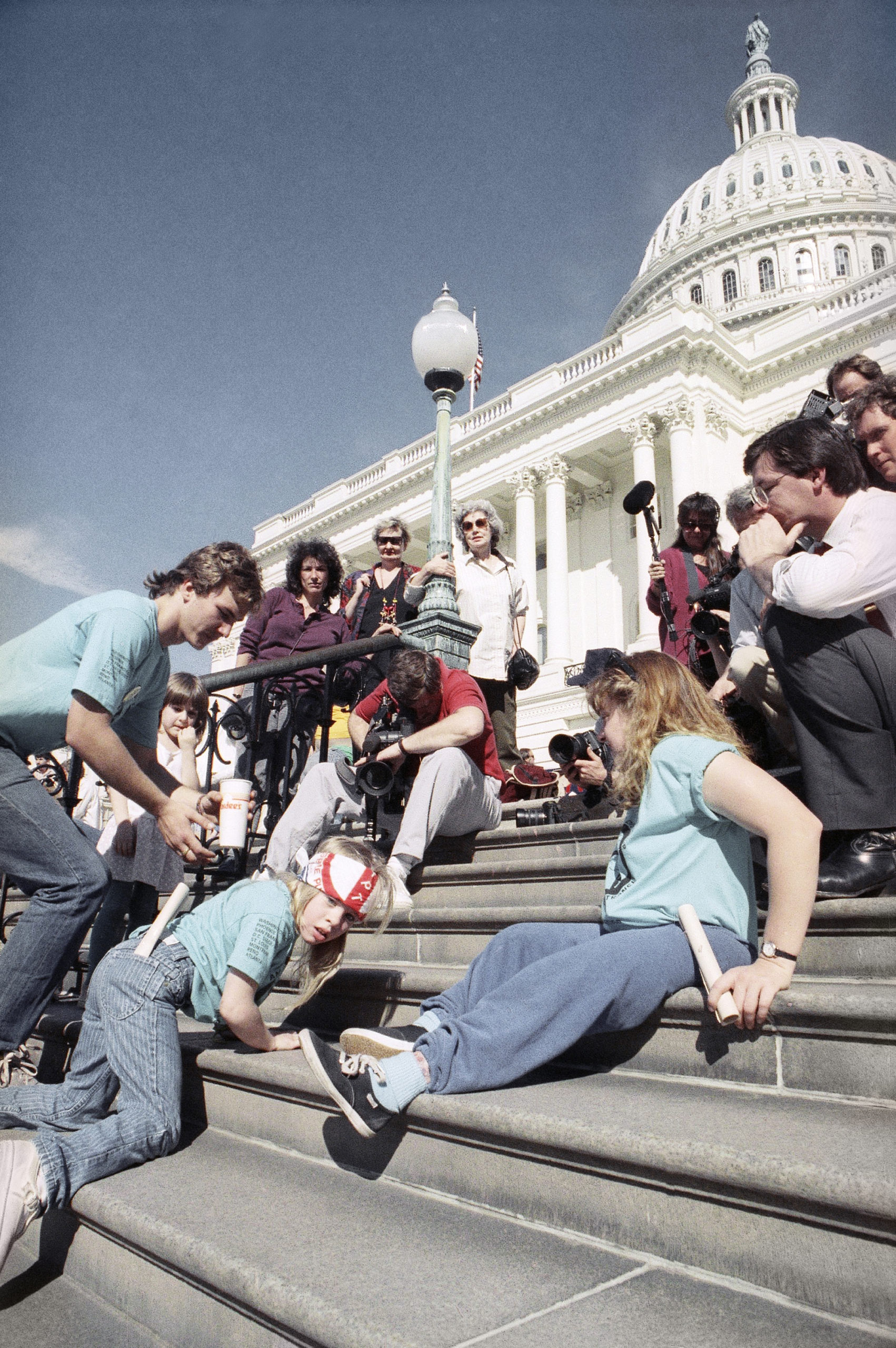 Primary Source: Photograph
Primary Source: Photograph
Members of the press and helpers gathered around Jennifer Keelan during the Capitol Crawl in 1990.
GAY RIGHTS
For most of our country’s history, most Americans did not think homosexuality was ok and in most states, it was against the law. However, after World War II, gay communities got started in many cities, especially San Francisco and New York City, and a movement grew to get rid of these laws and change people’s minds.
The Red Scare of the early 1950s hurt many Americans, especially gays and lesbians. In 1953, President Dwight Eisenhower signed Executive Order 10450, which stopped homosexuals from working in the government or military. Some people were worried that Soviet spies might be able to blackmail homosexuals and get them to give away government secrets. Only a few people ever lost their jobs because they were actually communist, but many lost their jobs because they were homosexual. Not only did they lose their jobs, but also they were forced out of the closet. In 2004, historian David Johnson wrote about this time in history and called it the Lavender Scare.
The start of the modern gay rights movement took place in New York City. Early in the morning of June 28, 1969, police raided a gay bar called the Stonewall Inn. This kind of raid was common, but this time things turned out differently. As the police got ready to arrest many of the customers, especially transsexuals and crossdressers who were often the targets of police harassment, a crowd began to gather. Angry about the way the police were acting, the crowd attacked. Beer bottles and bricks were thrown. The police tried to protect themselves inside the bar and waited for more police to arrive. The riot continued for several hours and started again the next night. Inspired by what happened at the Stonewall Inn, various gay rights groups united to protest discrimination, homophobia, and violence against gay people, and to work for gay pride.
With a call for homosexual men and women to come out, gay and lesbian communities started to get involved in politics. Gay rights activists tried to get the American Psychiatric Association (APA) to change its policy and say that homosexuality was not a mental illness. Because the APA had said being gay or lesbian was a mental illness, gay or lesbians often lost their jobs or custody of their children in court if they came out. By 1974, the APA had changed its official position.
More people began to change their mind about homosexuality being bad. In 1974 Kathy Kozachenko became the first openly lesbian woman elected to public office in Ann Arbor, Michigan. In 1977, Harvey Milk became California’s first openly gay elected man.
While the Stonewall Inn fight may have gotten the homosexual community to fight for equal treatment, it was a health crisis in the 1980s that really united them. In the early 1980s, doctors noticed something new. Young gay men in large cities were dying from a rare cancer. Because the disease was seen almost only in male homosexuals, it was first called Gay Related Immune Deficiency (GRID). But other people other than gay men, like drug users who shared needles, were dying from the disease also, so the disease was renamed Autoimmune Deficiency Syndrome (AIDS). Since AIDS first appeared among gay men, most heterosexuals didn’t worry about the growing health crisis in the gay community. They thought they were safe from it, even though this was not true. The government also did not worry about the disease, and leaders did not spend money to look for a cure.
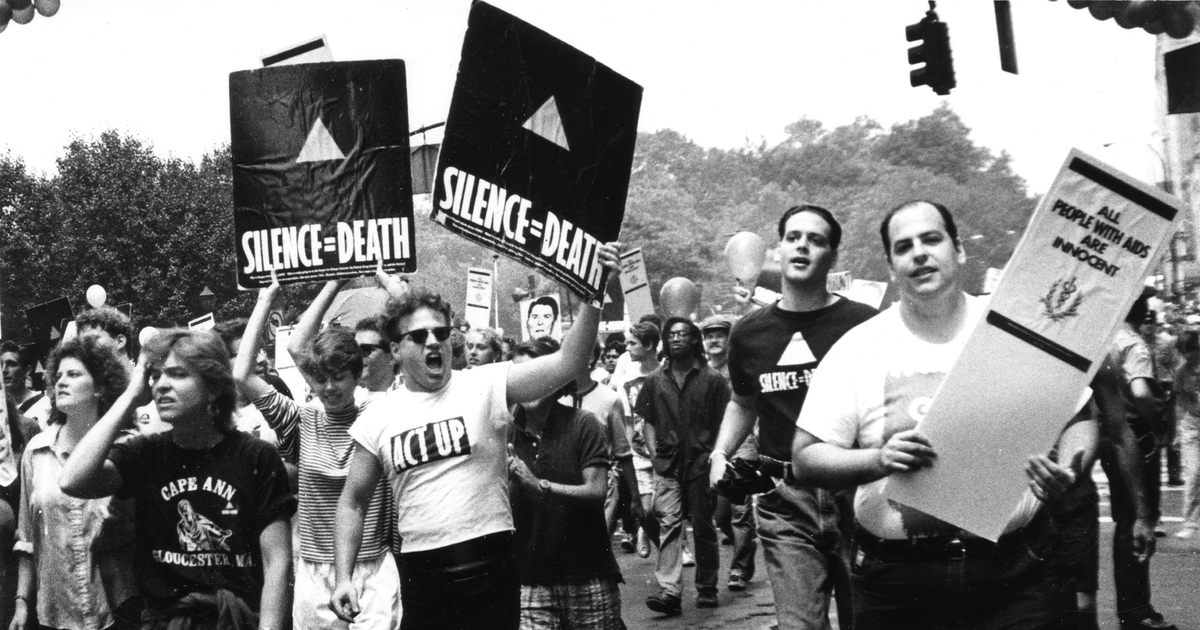 Primary Source: Photograph
Primary Source: Photograph
An ACT UP rally during the 1980s with signs with the pink triangle and Silence=Death message.
Sadly, the spread of HIV, the virus that causes AIDS, was not well understood and AIDS killed many people in the gay community and all around the world before leaders finally decided to act. Even after it was clear that heterosexuals could get HIV, most people still thought it was a disease that was only part of the gay community. This was most often true for political and religious conservatives. In fact, the Religious Right thought it as a form of punishment from God against gay men.
With little help coming from the government, the gay community organized its own fight against AIDS. In 1982, New York City men organized a volunteer information hotline, gave advice and legal help, and raised money for people with HIV and AIDS. Larry Kramer, one of the original members, started the AIDS Coalition to Unleash Power (ACT UP) in 1983. ACT UP marched on Wall Street, outside the headquarters of the Food and Drug Administration, and inside the New York Stock Exchange to call attention to the crisis and get leaders to take action. One of the images used by the group, a pink triangle with the words Silence=Death, got the attention of the news and became the symbol of the AIDS crisis.
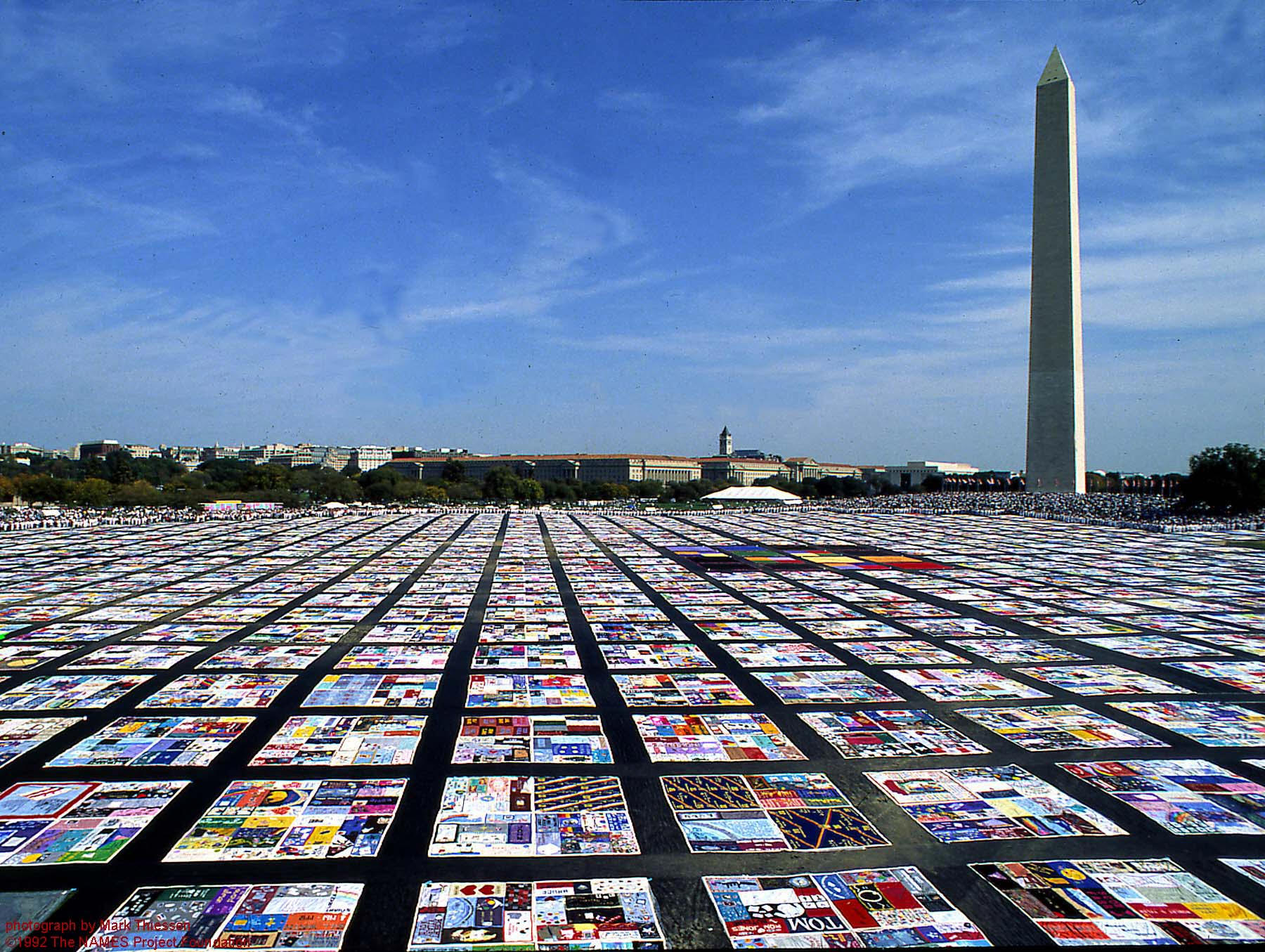 Primary Source: Photograph
Primary Source: Photograph
The AIDS Memorial Quilt laid out on the National Mall in Washington, DC. The Quilt has become an important symbol for the gay rights movement and the movement to find a cure for HIV/AIDS.
One of the most powerful images of the gay rights movement and the fight against AIDS has been the AIDS Memorial Quilt. Cleve Jones came up with the idea for the quilt in 1985. Jones had people write the names of loved ones that were lost to AIDS on signs, and then they taped the signs to a wall. All the signs taped to the building looked like a giant quilt and Jones was inspired to expand the project. At that time, many people who died of AIDS did not have funerals. Sometimes family members were ashamed and also, many funeral homes and cemeteries would not deal with the bodies of people who had died from the disease. Lacking a memorial service or grave site, The Quilt became an opportunity for families to remember and celebrate their loved ones’ lives. The first showing of The Quilt was in 1987 on the National Mall in Washington, DC. The Quilt has since been shown around the world.
By the 1990s, the gay rights movement was beginning to find support in government. In January 1993, Bill Clinton had just become president and he wanted to let homosexuals serve in the military again. But to get conservatives to agree, he proposed a new rule called Don’t Ask, Don’t Tell. Under this policy, people in the military would not be asked their sexual orientation and, if they were homosexual, they were not to talk about it or they would have to leave the military. This did not make anyone happy. Homosexuals wanted to serve in the military openly and conservatives wanted them out. Don’t Ask, Don’t Tell continued until 2011 when the military leaders, President Barack Obama and Congress all voted to end the policy and allow gays and lesbians to serve openly in the military.
President Bill Clinton also gave in to conservatives when he signed the Defense of Marriage Act (DOMA). DOMA said marriage could only be between a man and woman and said that gay or lesbian couples could not get federal benefits. It also let states ignore same-sex marriages from other states. When Clinton signed the law, he was against same-sex marriage. Like many democratic leaders, he later changed his mind about same-sex marriage. On other topics Clinton was more open to change. He gave gay and lesbian men and women to important jobs in government and said that discrimination against people with AIDS was wrong.
As the 2000s began, state governments began to go against DOMA. Vermont became the first state to agree to civil unions, a legal agreement between two people that gave them the same rights as married couples. In this way, homosexual couples could own things together, adopt children, have next-of-kin access in cases of medical care, as well as get money in the case of separation. For many, this was seen as a step forward and other states followed Vermont’s lead. Yet for many couples, a civil union would never mean the same as being married.
The first 20 years of the 2000s saw a big change in the way Americans thought about same-sex marriage. Famous people in the African American civil rights movement, including Coretta Scott King, John Lewis, Julian Bond, and Mildred Loving publicly said they supported same-sex marriage. In May 2011, a poll found that for the first time more than 50% of all Americans liked the idea of same-sex marriage. In June 2013, the Supreme Court said that DOMA was unconstitutional in the case of United States v. Windsor. Finally in June 2015, the Supreme Court said that gay and lesbian couples have the same right to get married as anyone else in the case of Obergefell v. Hodges and same-sex marriage became legal in all 50 states.
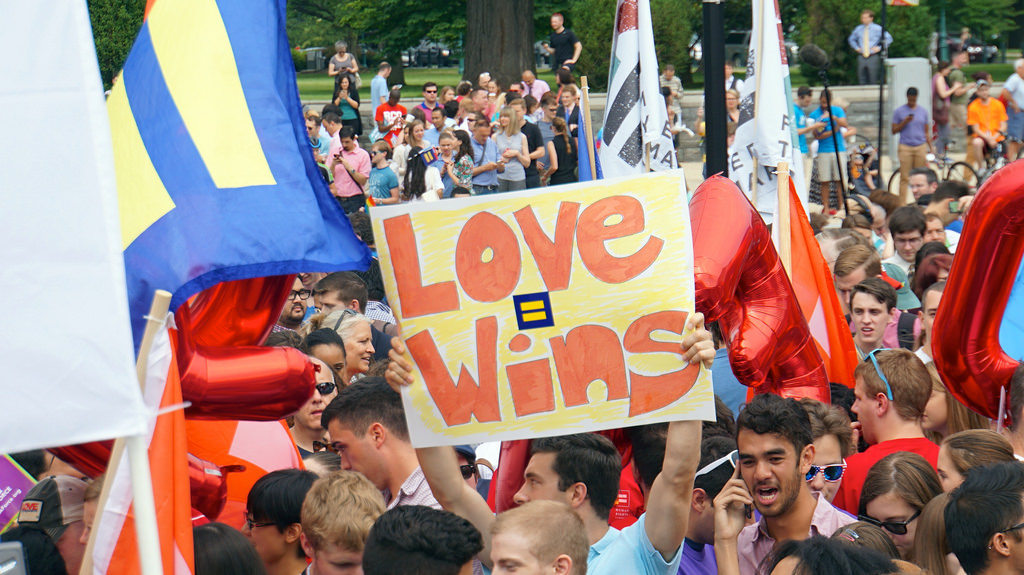 Primary Source: Photograph
Primary Source: Photograph
The = symbol and the slogan “Love Wins” became powerful images, especially in social media, during the campaign for marriage equality.
In the same way that people became more accepting of same-sex marriage, there was more acceptance of homosexuality in general. Gay and lesbian actors started playing positive roles on television and movies. Athletes have come out and been accepted by teammates and fans. There are now Senators and Representatives in the Congress who are open about being homosexual. Most businesses also have rules to protect their gay and lesbian employees and customers from discrimination.
CONCLUSION
The movements that were inspired by and followed the African American Civil Rights Movement of the 1950s and 1960s were all different.
For the Mexican American farm workers of California, they did many of the same things as the African Americans. They marched and boycotted. They also had good leaders. However, they mostly worked to fix problems at their jobs and not bigger problems like voting rights or problems with the police.
The American Indian Movement was very different. They carried guns and took over land and buildings and started fights with the government. Sometimes these fights were solved, but sadly, not always. Similar to the African American community, the Native Americans found a sense of pride in their work, but only won in court or got the government to change.
Disabled Americans had a big victory with the Americans with Disabilities Act but have had to go to court many times to get businesses to follow the law.
Most recently, homosexual Americans went through a long fight to be treated equally. Through protests, marches, and the courts, and in the face of health crisis and prejudice, in just the past few years they have had important victories at the national level.
What things led to these changes, and what things held these movements back? What combination of leadership, timing, method, and public support worked?
What do you think? What makes a movement successful?
CONTINUE READING

SUMMARY
BIG IDEA: Other groups were inspired by the African Civil Rights Movement and worked to improve their own standing in society. Hispanics, disabled and LGBTQ Americans all worked successfully to advance their rights. While these movements were mostly peaceful, the American Indian Movement included violent confrontations with government.
Hispanic Americans had won important victories in the court system in the 1940s and 1950s similar to victories won by African Americans. However, the biggest victories were because of the work of Cesar Chavez and the United Farm Workers in California. They led a strike and boycott against grape growers and eventually won using nonviolence.
The Chicano Movement was a broader nationwide effort to promote Hispanic rights, identity and pride. It included organizing political groups, fighting for rights in the courts, and new music and art.
Native American activists formed AIM in 1968 to campaign for their rights. AIM occupied Alcatraz Island, led a march to Washington, DC where they occupied the offices of the Bureau of Indian Affairs and also led a standoff at Wounded Knee. In each of these cases, their movement was more violent than the African American and Hispanic efforts. However, laws were passed that gave Native American tribes more control over their land and finances, and the movement led to an increased sense of pride.
Disability rights activists worked to pass the Americans with Disabilities Act (ADA). They succeeded in 1990 and now business and organizations have to ensure that their buildings and services are accessible to people with disabilities. There is still some opposition to the law from groups who believe the requirements (such as installing elevators) are too expensive.
The gay rights movement stated in 1968 when police raided a gay bar in New York City and the customers fought back. The movement gained momentum due to the AIDS crisis in the 1980s when the disease first spread among gay men.
During the Red Scare of the 1950s, a law was passed to prohibit homosexuals from working for the government. In the 1990s, President Clinton implemented “don’t ask, don’t tell” which allowed homosexual Americans to serve in the military so long as they did not reveal their sexual orientation. This policy did not end until 2011. Today homosexual Americans can serve openly in the military and government.
Also during the 1990s, Americans started to debate gay marriage. Some states began allowing gay marriage while others banned it. A federal law allowed states to ignore gay marriages passed in other states. Eventually in 2015, the Supreme Court ruled that gay marriage was a constitutional right.

VOCABULARY
![]()
PEOPLE AND GROUPS
Cesar Chavez: Leader of the United Farm Workers and champion of the rights of Hispanic farm workers
Dolores Huerta: Co-founder of the National Farm Workers Association and champion of the rights of Hispanic farm workers.
Larry Itliong: Leader of the Filipino farm workers in California who merged his union with the Hispanic farm workers union led by Cesar Chavez to form the United Farm Workers.
United Farm Workers: Union of Filipino and Hispanic farm workers in California led by Cesar Chavez.
Rodolfo “Corky” Gonzales: Mexican American boxer, poet, and one of the first political activists of the Chicano Movement.
La Raza Unida: Chicano political organization that was founded in the early 1970s and became prominent throughout Texas and Southern California where its members ran for office in local elections.
Reies López Tijerina: Chicano political activist who helped Hispanics reclaim lands their families had lost when the United States took the Southwest from Mexico in the 1840s.
Dennis Banks: Native American activist and co-founder of the American Indian Movement (AIM) along with George Mitchell.
George Mitchell: Native American activist and co-founder of the American Indian Movement (AIM) along with Dennis Banks.
American Indian Movement (AIM): Native American political organization founded in 1968. They organized various protests including the occupation of Alcatraz Island, Trail of Broken Treaties and occupation of Wounded Knee.
Russell Means: American Indian Movement activist and one of the leaders of the Wounded Knee occupation. He went on to a career in Hollywood but continued to advocate for Native American rights.
Leonard Peltier: Native American activist and AIM member who was convicted in 1977 of the murder of two FBI agents. He has become a symbol of the conflict between Native Americans and the federal government.
Harvey Milk: First openly gay man elected to a public office in the United States. He served on the San Francisco Board of Supervisors until he was murdered.
![]()
KEY IDEAS
Aztlán: Mythical name for the lands of Northern Mexico that were annexed by the United States at the end of the Mexican-American War. The idea of Aztlán has been used to develop as sense of communal identity by Chicano activists.
Civil Union: A legal agreement between homosexual partners that served as a substitute for marriage in some states. It granted the same legal rights as marriage without the title.
![]()
SCIENCE & TECHNOLOGY
AIDS: Illness caused by HIV that was first detected in the 1980s and mistakenly believed to infect only gay men. It devastated the gay community and because the federal government was slow to respond to the growing crisis, sparked organization and activism in the gay community.
![]()
COURT CASES
Mendez v. Westminster: 1947 court case that ended segregated schools for Hispanic students.
Hernandez v. Texas: 1954 Supreme Court case in which the court concluded that Fourteenth Amendment protections should be extended to all ethnic groups. Specifically in this case, Hernandez argued that he should not be tried by an all-White jury.
Madrigal v. Quilligan: Court case in which Spanish-speaking women had been sterilized after signing documents they could not read. The case resulted in forms being published in multiple languages.
Obergefell v. Hodges: 2015 Supreme Court case that declared gay marriage constitutional in all 50 states.
![]()
EVENTS
Delano Grape Strike and Boycott: Major strike and boycott during the 1960s in California by the United Farm Workers to win guarantees of humane treatment of workers and better pay.
Chicano Movement: Movement of Hispanic Americans beginning in the 1960s that focused on civil rights. It involved the development of political institutions and was marked by an increased sense of community pride as well as a flowering of artistic expression and literature.
Occupation of Alcatraz Island: Political occupation of an island in San Francisco by members of AIM in 1969-1970.
Trail of Broken Treaties: Pilgrimage from California to Washington, DC in 1972 organized by AIM and other Native American activists. Once in DC, they occupied the offices of the Bureau of Indian Affairs and presented a list of demands to be read by President Nixon.
Occupation of Wounded Knee: Violent 71-day standoff between AIM activists and the federal government in 1973.
Capitol Crawl: Protest in 1990 in which disabled Americans crawled up the steps of the Capitol Building in Washington, DC without their wheelchairs, canes, etc. to push for passage of the Americans with Disabilities Act (ADA).
Lavender Scare: Persecution of homosexual federal employees during the early 1950s that coincided with the hunt for communists.
Stonewall Inn Riots: Violent confrontation between New York City police and gay men at a bar in 1969. The event sparked the modern gay rights movement.
AIDS Memorial Quilt: Collection of sewn memorials to Americans who died from AIDS and AIDS-related illnesses. It was first displayed in full in Washington, DC on the National Mall.
![]()
LAWS & POLICIES
Indian Self-Determination and Education Assistance Act of 1975: Law passed in 1975 that gave federal money to Native American tribes in the form of grants that the tribes could spend as they wished. It was in important step in allowing Native Americans great self-government.
Americans with Disabilities Act (ADA): 1990 law that guaranteed protections to people with disabilities, including signage in Braille, wheelchair ramps, access lifts, handicapped parking spaces, etc.
Don’t Ask, Don’t Tell: Policy adopted by the Clinton Administration in the 1990s that allowed homosexual Americans to serve in the military so long as they didn’t reveal their sexual orientation. In turn, the military would not actively try to find out their orientation. It ended the days of an open ban on service.
Defense of Marriage Act (DOMA): Law passed in 1996 that defined marriage as between one man and one woman. It prohibited the federal government from recognizing gay marriages and allowed states to ignore gay marriages issued in other states. It was overturned in 2015.


